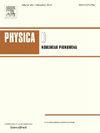Automatic classification of magnetic field line topology by persistent homology
IF 2.7
3区 数学
Q1 MATHEMATICS, APPLIED
引用次数: 0
Abstract
A method for the automatic classification of the orbits of magnetic field lines into topologically distinct classes using the Vietoris–Rips persistent homology is presented. The input to the method is the Poincare map orbits of field lines and the output is a separation into three classes: islands, chaotic layers, and invariant tori. The classification is tested numerically for the case of a toy model of a perturbed tokamak represented initially in its geometric coordinates. The persistent data is demonstrated to be sufficient to distinguish magnetic islands from the other orbits. When combined with persistent information, describing the average spacing between points on the Poincare section, the larger chaotic orbits can then be separated from very thin chaotic layers and invariant tori. It is then shown that if straight field line coordinates exist for a nearby integrable field configuration, the performance of the classification can be improved by transforming into this natural coordinate system. The focus is the application to toroidal magnetic confinement but the method is sufficiently general to apply to generic d Hamiltonian systems.
基于持续同调的磁力线拓扑自动分类
提出了一种利用Vietoris-Rips持续同调将磁力线轨道自动分类为拓扑不同类的方法。该方法的输入是场线的庞加莱映射轨道,输出是三类分离:岛屿,混沌层和不变环面。该分类是对一个玩具模型的情况下进行数值测试的扰动托卡马克最初表示在其几何坐标。持久的H1数据被证明足以将磁岛与其他轨道区分开来。当与描述庞加莱截面上点之间平均间距的持久H0信息相结合时,可以从非常薄的混沌层和不变环面中分离出较大的混沌轨道。结果表明,如果附近的可积场构型存在直线场坐标,则转换为该自然坐标系可以提高分类性能。重点是应用于环面磁约束,但该方法是足够普遍,适用于一般的112d哈密顿系统。
本文章由计算机程序翻译,如有差异,请以英文原文为准。
求助全文
约1分钟内获得全文
求助全文
来源期刊

Physica D: Nonlinear Phenomena
物理-物理:数学物理
CiteScore
7.30
自引率
7.50%
发文量
213
审稿时长
65 days
期刊介绍:
Physica D (Nonlinear Phenomena) publishes research and review articles reporting on experimental and theoretical works, techniques and ideas that advance the understanding of nonlinear phenomena. Topics encompass wave motion in physical, chemical and biological systems; physical or biological phenomena governed by nonlinear field equations, including hydrodynamics and turbulence; pattern formation and cooperative phenomena; instability, bifurcations, chaos, and space-time disorder; integrable/Hamiltonian systems; asymptotic analysis and, more generally, mathematical methods for nonlinear systems.
 求助内容:
求助内容: 应助结果提醒方式:
应助结果提醒方式:


